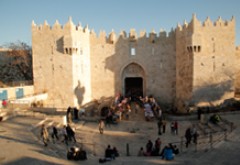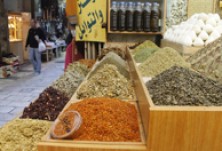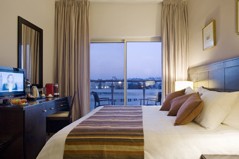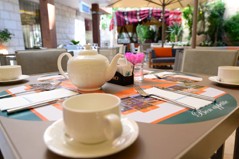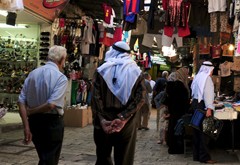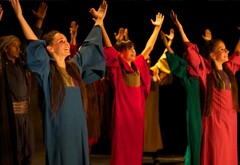The 1967 war brought the remaining part of Jerusalem under Israeli occupation. The city faced dramatic changes, with East Jerusalem annexed to Israel, and the declaration of the "united city" as the capital of Jerusalem. Bulldozers were brought into the city to demolish Al-Magharibah neighborhood, forming a huge square in front of Al-BuragWall. A large part of the Old City, betweenAl-Burag Wall and the Armenian Quarter was confiscated, to be known later on as the Jewish Quarter. This area was rebuilt, under the premise that what was done does not relate to the concepts of restoration, producing an architectural style alien to the Old City, but with a clear political tone.
Israel annexed East Jerusalem, expanded the municipal boundaries by over 72 square kilometers at the expense of the West Bank, thus guaranteeing vast empty land on which to build Jewish settlements, suffocating the Palestinian residents of Jerusalem, who were given a conditional right to stay in Jerusalem, as if they were illegal visitors who stayed in the city, thus exposing them to the continuous risk of displacement.
Outside the city walls, Jerusalem was exposed to a horrific settlement assault, culminating after three decades in complete control of all empty land, including agricultural land, nature reserves, and land suitable for construction development surrounding Jerusalem. A systematic process of insulation of Arab Jerusalem from its Palestinian environment took place throughout the rest of the West Bank. Today, a Palestinian cannot enter or leave Jerusalem without passing through a Jewish settlement. This policy also had a demographic dimension, represented in attempting to settle Jews inside Arab Jerusalem to create a Jewish majority there. This policy culminated in the construction of the Apartheid wall which surrounded Palestinian residents and prevented them from communicating with their families and livelihoods, except through specific gates through which Palestinians pass as if crossing from one state to another, under humiliating meticulous inspection.
Israeli policies regarding the "right to citizenship" for Palestinians affected the residence movement and the shape of the Old and New city, starting with the end of the second millennium, with huge numbers of Palestinians moving from outside the city (based on the Israeli delineation of the municipal borders) to live once again inside the Old City walls, creating an unhealthy construction movement, represented mostly by additions to old buildings, using unsuitable materials and without proper supervision. It was also represented in the concentrated use of space that surpassed the accommodation capacity of the Old City, including transforming some basements originally built as storage areas and stables for residential purposes, or even transforming shops into residences. These developments surely led to deteriorating living standards, particularly that most returnees to the Old City were from the disenfranchised, and families with many children.
As a matter of fact, what the Palestinian villages outside the Old City suffered from was basically not different from those inside the Old City. The residential crisis affected these neighborhoods and transferred them into shanty towns of poverty and corrugated steel. Suffice it to know that building permits issued for Palestinians by the occupation forces' municipality in Jerusalem does not exceed, since 1967, 2% of the total number of permits issued. The majority went to Jews, although the Palestinian residents of Jerusalem represent one third of the city population, in addition to the large scale demolitions from which Palestinian neighborhoods suffer, under the pretext of unlicensed construction.
This period also witnessed the emergence of Palestinian institutions concerned with restoring the Old City. The first initiative came at the end of the 1970s, when the Islamic Awqaf Department undertook extensive restoration work in Al-Haram Al-Sharif, in the wake of the burning of Al-Aqsa Mosque in 1969. The same applies for the area surrounding the Haram, focusing on Mamluk buildings, including schools, hostels, Ribats, and mosques. During the first Intifada (popular uprising) the Social Welfare Association was formed (renamed later as the Jerusalem Welfare Association) in the Old City, with the aim of improving the living conditions and protecting real estate from transferring to undesired owners. It restored dozens of buildings, in order to eventually move to a stage of total renovation of full buildings or whole residential segments with the arrival of the third millennium. This way, the association completed the restoration of hundreds of residential units.
Furthermore, the Orient House carried out similar restoration efforts towards the end of the 1980s and the beginning of the 1990s, but at a more limited rate, within the efforts to reinforce the steadfastness of the Old City residents. The Center for Architectural Conservation - Riwaq (since 1991) contributed to restoring a number of buildings, and registered every building in the Old City. The Welfare Institution established a technical unit in 1994, for the purpose of developing the Old City, restoring hundreds of buildings, and has developed a comprehensive plan, in association with a number of institutions and experts, to restore and develop the Old City, which was completed in 2001. It is noteworthy that work done by the Welfare Institution has been characterized by professionalism and recognized international standards. The Papal mission and different churches contributed to restoration and maintenance work in a number of buildings. All these achievements still fall short of a comprehensive restoration achievement of the Old City, due to the complexity of its nature and the increased Israeli interference which hinders the work carried out by these organizations, whereby the Archaeology Authority and the Israeli occupation municipality make incessant attempts to enforce prohibitive conditions. What has been achieved so far, however, is truly an amazing effort, taking into consideration the prevailing conditions.
Archaeological excavations have recently (2010 - 2013) intensified, with the pretext of searching for archaeological artifacts, in the area surrounding Al-Aqsa Mosque, revealing a number of tunnels in various directions. All tunnel projects have not been clarified as yet. In addition to the tunnel excavated along the western wall of Al-Haram Al-Sharif, other tunnels are being excavated leading from outside the walled city, particularly in the southern part, inwards to meet in Al-Buraq Square. There are also plans to excavate a tunnel starting from the Solomon cave (Zedekiah's Cave) towards Bab Al-Wad, and further on to the Buraq Square.
In addition, announcements were made about projects to excavate tunnels from the Jewish Quarter to Al-Buraq Wall. Most of these tunnels are not announced, and are treated with great secrecy. In any case, if these tunnels were to be excavated, we shall see a new image of the Old City. It is not possible at this stage to estimate the magnitude and effect of these tunnels on the city and its cultural heritage.
There is a comprehensive scheme to redesign Al-Burag Square by adding two buildings, one on the north wall of the Square, and the other on the south wall. Each building will comprise a number of floors. A series of buildings are also planned under the Square. The Bab Al-Magharibah Gate (Dung Gate) has not been finalized yet, as far as how the planned bridge will look like, connecting Al-Buraq Square to Al-Haram Al-Sharif. Furthermore, the project to expand Al-Buraq the expansion of Al-Buraq Wall towards the south or the form of the Tankaziyah School roof are not clear yet, whereby it is planned to add a synagogue on top of the building.
The cultural scene surrounding the Old City from the south and west is undergoing dramatic changes which led, so far, and will lead, in future, to alienating the historic image of the Old City, and attempt to impose a cultural identity which is in contrast with the prevailing one for many centuries.
What is clear now (2013) is the connection between archaeological sites and excavations with Jewish settlement and expansion in the Old City. Furthermore, the majority of the excavation work mentioned above is being financed by Jewish settlement movements which aim at controlling Jerusalem and displacing its Palestinian residents, replacing them with Jewish settlers.
The struggle inside the Old City is concentrated on Al-Haram Al-Sharif and the surrounding area, with this location becoming a symbol of this struggle.
That is not to say that the rest of the neighborhoods are any less important, ith a struggle taking place over every building. Outside the Old City, the struggle is represented in displacing the largest possible number of Palestinians out of Jerusalem, or even out of Palestine. The settlement movement's pace is rising in a very dramatic way, and actions to insulate Jerusalem from the West Bank in different ways is becoming tangible by the hour in the lives of the Palestinians, whose number is close to 400,000, with a living space that has become totally overwhelming.
What Palestinians suffer from in Jerusalem also affects their religious and civil institutions. Many service, representation, and cultural institutions, and the ones remaining are being exposed to continuous harassment. In return, Palestinian citizens are being connected to the Israeli institutional cycle, in order to neutralize their cultural and national identity.
The fate of Jerusalem is still undecided, and political negotiations are either continuing or stalled, to decide on its future. It is still being subjected to processes to change it cultural image; processes that are sometimes called "Israelization," and sometime "Judaization." The current result is that it is subjected to unusual pressure to change its image. In return, there a Palestinian civil resistance and an attempt to hold on to the remnants of this identity.

